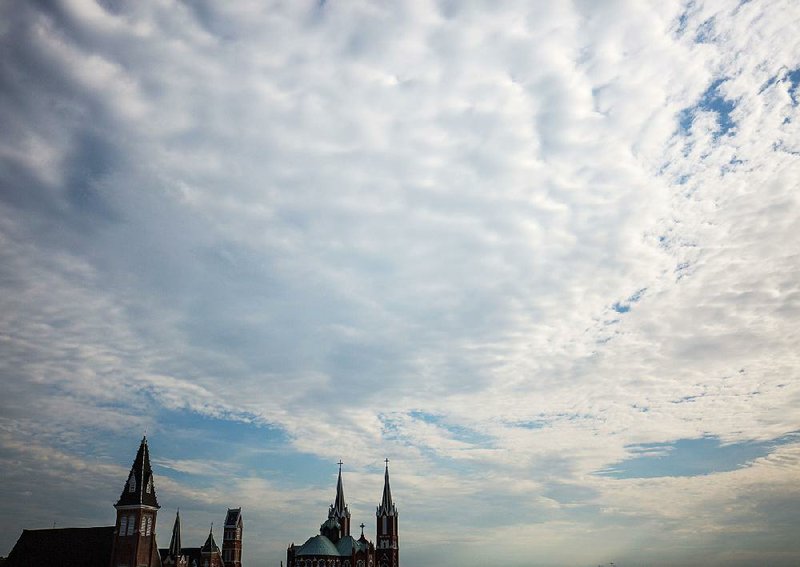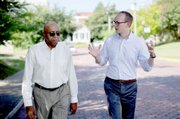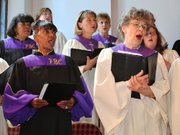MACON, Ga. -- There are two First Baptist churches in Macon -- one black and one white. They sit almost back-to-back, separated by a small park, in a hilltop historic district overlooking downtown.
"We're literally around the corner from each other," said the Rev. Scott Dickison, pastor of the white church.
About 170 years ago, they were one congregation, albeit a church of masters and slaves. Then the fight over abolition and slavery started tearing badly at religious groups and moving the country toward the Civil War. The Macon church, like many others at the time, decided it was time to separate by race.
Ever since -- through Jim Crow, the civil rights movement, desegregation and beyond -- the division endured, becoming so deeply rooted it hardly drew notice.
Then, two years ago, Dickison and the pastor of the black church, the Rev. James Goolsby, met over lunch and an idea took shape: They'd try to find a way the congregations, neighbors for so long, could become friends. They'd try to bridge the stubborn divide of race.
They are taking up this work against a painful and tumultuous backdrop: the massacre last year at a historic black church in Charleston, S.C.; the much-publicized deaths of blacks at the hands of law enforcement; the rise of the Black Lives Matter movement; and the sniper killing of white Dallas police officers. These events, and the tensions they have caused, have become part of the tentative new discussions among congregants at the two First Baptists.
This month, the pastors will take their most ambitious step yet, leading joint discussions with church members on racism in the history of the U.S., and also in the history of their congregations.
"This is not a conversation of blame, but of acceptance and moving forward," said Goolsby.
RACIAL DIVIDES
The South is dotted with cities that have two First Baptist churches.
In the early 19th century, before the Civil War, whites and blacks often worshipped together, sharing faith but not pews; blacks were restricted to galleries or the back of the sanctuary. Eventually, black populations started growing faster in many communities. Whites, made uneasy by the imbalance, responded by splitting up the congregations.
This was apparently the case for First Baptist in Macon.
In 1845, church leaders bought property a block away, as "a place and habitation for the religious service and moral cultivation and improvement of the colored portion" of the congregation, according to the deed. A building was quickly erected and the black church opened.
That was a year when tensions between anti- and pro-slavery Baptists boiled over nationwide, leading Southerners to break away and create their own denomination, the Southern Baptist Convention, which upheld slavery as ordained by God. The white Macon congregation, known as the First Baptist Church of Christ, became Southern Baptist.
Whites maintained oversight of the black church as required by Georgia law at the time, for fear of slave rebellions. But after the Civil War ended in 1865, the white church fully severed ties.
The two First Baptist Churches stayed that way, just steps from each other but apart, ever since.
Like many other American institutions, houses of worship have largely been separated by race, to the point that the Rev. Martin Luther King Jr. called Sunday mornings "one of the most segregated hours." Recently, more churches have tried to diversify and to look critically at their past actions and teachings, with denominations from the Southern Baptist Convention to the Episcopal Church making a priority of fighting racial bias.
WORKING TOGETHER
When Goolsby last year told the black church of the plan to work with the white congregation, people applauded. White congregants were enthusiastic as well. Yet, it was excitement mixed with some apprehension, since the effort would inevitably require "some challenging conversations," Dickison said.
"It's hard to talk honestly about race," said Doug Thompson, a member of the white church and also a Mercer University professor who specializes in religion and race. "It's always hard to help people move forward."
The two churches' first activity together was modest but symbolically significant. For years, each church held its Easter egg hunt in the same tree-shaded park behind their churches, but at different times. Last year, they met there together.
As the churches held other combined activities -- a book drive, a Thanksgiving potluck -- some participants were so moved they had tears in their eyes. There were members of both churches who said they had been waiting for decades for such a reunion.
"I thought it would be a great opportunity and a blessing," said Bea Warbington-Ross, a retired human resources specialist and member of Goolsby's congregation.
Congregants were surprised to learn their sanctuaries had nearly identical designs, with vaulted ceilings that resembled the inverted hull of a ship. Warbington-Ross lives in the historic district five blocks from the white church, which some of her neighbors attend. She'd never been inside.
MAKING A COMMITMENT
The congregations sealed their commitment to each other at a joint Pentecost service at the black church. Before a choir drawn from both congregations, leaders pledged to work together under the auspices of the New Baptist Covenant, an organization formed by President Jimmy Carter to unite Baptists.
But the pastors acknowledge the long journey ahead. They are tackling what some call the original sin of the country's founding.
In Macon, where plaques and monuments commemorating Confederate soldiers' valor adorn street corners and parks, white congregants will be asked to re-examine their church history, which until recently had been officially recorded in mostly benign terms.
The review is so sensitive that Goolsby had suggested early on that the two churches wait to address the past until they built more mutual trust and good will. Dickison, acknowledging that some congregants will be embarrassed and some distressed or resistant, considers the conversation vital.
"A white person from the South -- to not come to terms with our own history and experience with race is to deprive ourselves of a full understanding of the Gospel. We need to go through this kind of conversion experience of confession, of repentance and of reconciliation. We need to have that when it comes to race, not just in the country but within the church," Dickison said.
Goolsby, a 59-year-old Atlanta native and graduate of Morehouse College and Mercer's McAfee School of Theology, has been pastor at the black church for more than 12 years. He said he and a previous pastor at the white church tried to build ties between the congregations but the effort didn't go very far.
This time is different, he said, in part because of his relationship with Dickison. The 33-year-old North Carolina native and Harvard Divinity School graduate became a pastor in Macon about four years ago.
He recalled that after the attack last year on the Charleston church, he was in the parking lot of a J.C. Penney store, waiting for his wife, when Dickison called.
"Scott shared how he felt, how he was struggling with what he would share with his congregation," Goolsby said. The two discussed the history of violence against black churches, and Dickison asked how he could show support.
"I said, 'We're already doing it,'" Goolsby said. "The mere fact he thought to call me was huge."
The stakes were even more personal about six months later, when the white church invited black church members for a youth trip to Orlando, Fla.
Goolsby's teenage son was among those invited. But Goolsby had considered Florida a danger ever since Trayvon Martin, an unarmed, black 17-year-old, was fatally shot in Sanford by George Zimmerman, a neighborhood watch volunteer who was later acquitted of second-degree murder and manslaughter charges.
The pastor could not let his son go on the trip. "If you put a hoodie on him," he said, "he looks just like Trayvon."
The concerns of anxious black parents had been much in the news amid the shootings of black men. But the white church members hadn't had to confront the issue directly until Goolsby raised it.
"It's one thing to understand it intellectually and another thing to understand it emotionally. Once he said that, I could feel it," said David Cooke, a white deacon, who is also the Macon-Bibb County district attorney.
Cooke was to be a chaperone on the Orlando trip. He promised Goolsby he would be especially watchful. The trip went ahead safely with young people from both congregations -- including the pastor's son.
"The fact that that was so easy to share -- we've already made progress," Goolsby said.
OVERCOMING FEAR
Dickison strode into the basement hall of his church with a box under one arm. Inside were copies of Strength to Love, a collection of sermons and writings by King. The book was at the center of classes that Dickison organized on racism for the white church, in preparation for the talks this month.
But the readings had extra significance that morning. It was the Sunday after the fatal police shootings of Alton Sterling in Louisiana and Philando Castile in Minnesota, and the fatal ambush on Dallas police. "It's weeks like these when we need more than ever to be with God's people," Dickison told the roomful of congregants.
With the stifling humidity of a Georgia summer building outside, he launched into a discussion of King's sermon on the parable of the Good Samaritan, about despised groups and showing mercy.
"We have our tribes. We see ourselves over and against others," he said, then asked church members to reflect.
One man said when you reach out to someone from another group, "you're perceived as unpatriotic," or disloyal.
A woman said fear often kept people from crossing racial divides. "What if you make it worse?" she asked.
Another woman said she was upset to see some disrespect of the police. She compared law enforcement officers to the Good Samaritan, who helped a wounded stranger others had ignored. "They rush toward danger when others run," she said.
At a Black Lives Matter vigil the next nightGoolsby and Dickison sat side-by-side at the pulpit, swaying along with the hymns, then stood together to speak. Dickison compared racism to "a cancer that roams inside the body of this nation, and yes, even in the body of Christ." Goolsby urged people to maintain hope "in spite of our circumstances," and he added, "We know there will be change."
Said both men: "Amen."
Religion on 09/10/2016


